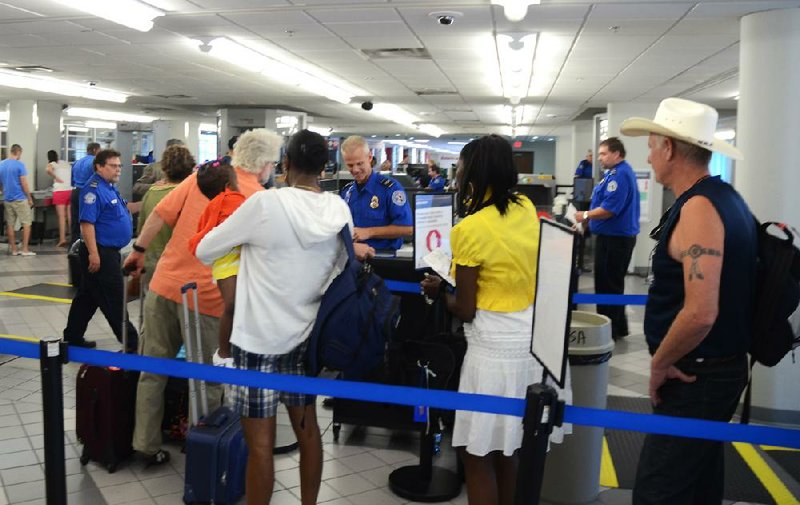LITTLE ROCK — The state’s largest airport wants to remove the guesswork in how long lines are at its passenger security-checkpoint area.
As early as next month, Bill and Hillary Clinton National Airport/Adams Field will begin a two-month pilot program using a system of sensors and other equipment to gauge precisely how much time it takes passengers to transit the checkpoint.
The program is one of a host of measures the airport has undertaken to limit the long waits passengers say they are enduring to clear security.
At the end of the evaluation period, the airport will have the option to purchase the equipment for $90,000, said Ron Mathieu, the executive director at Clinton National. Assuming that happens, passengers will be able to check the lines before they arrive at the airport, he said.
The system will employ 16 sensors in the security area that will track each passenger through the process.
“Ultimately, when all that is said and done, we will have the ability of posting these processing times either on our website, on mobile platforms, in the terminal so that customers will know [whether] it’s currently a 15-minute wait or it’s currently a 10-minute wait,” Mathieu said. “They’ll know that, and that information will not be subjective.”
At the monthly meeting of the Little Rock Municipal Airport Commission last week, commission member Tom Schueck questioned the cost of the system should the airport agree to purchase it. Mathieu noted the equipment purchase is a one-time cost, and that the annual maintenance and licensing fees have been negotiated down to $8,000 from $21,000.
The cost seems steep but not against the price of stationing airport employees at the checkpoint to measure waiting times, Mathieu added.
“What I’m looking at is the cost of the human assets to collect information that’s nowhere near as accurate as this will be,” he said. “I dare say the cost of the human assets on a regular basis would be more than the cost of this system.”
In dealing with passenger complaints about wait times, the airport staff discovered a discrepancy between what the Transportation Security Administration measures as the wait time and what the airport staff, and likely passengers, consider a wait time, which Mathieu said is one reason accounts of the wait times from the agency and from passengers differed.
“We have a difference of opinion with our friends in TSA as to what constitutes a wait time,” Mathieu told the commission last week.
The agency has been timing passengers from the moment they enter the line to the time they reach the officer who checks their identification and tickets, he said.
“That’s not how our customers look at it and, therefore, that’s not how I think we should look at it,” Mathieu said. “The customers look at the wait time from the moment they get in line to when they walk out of the checkpoint.”
An agency spokesman, Sari Koshetz, confirmed that the Transportation Security Administration doesn’t time the whole process.
“We look at the time it takes to enter the screening process and get to the walk through metal detector or Advanced Imaging Technology machine,” she said in an e-mail. “So far this month, there have been only three moments in time when the wait time was more than 20 minutes and those times were 21, 25 and 26 minutes.”
For its part, the agency said too many variables exist once passengers go beyond the officer checking their tickets and identification to accurately measure wait times inside the checkpoint area.
“The time to traverse security - even with our best people, processes and technology in place - involves passenger behavior and preparation,” Koshetz said. “Processing someone through security is very quick if a person comes to the checkpoint prepared.”
That involves emptying their pockets of everything, including items that could cause an alarm, before they reach the metal detectors or body scanners, as well has having no prohibited items in their carry-on luggage, she said, calling it the “quickest and least stressful way to go.”
But too frequently, Koshetz said, passengers don’t empty their pockets until they reach the bins, which keeps other passengers waiting, or they are carrying something they cannot take aboard an airline flight.
“People still continue to bring knives, other lethal weapons, over sized liquids, gels and aerosols, and a variety of prohibited items to the checkpoint, requiring bag searches and other delays both for themselves and for the people in line behind them.”
Complaints surfaced in March, less than three months after the airport unveiled a $1.7 million expansion of its passenger security checkpoint. The 3,000-square-foot expansion was the first to be completed as part of the $67 million first phase of the airport’s terminal redevelopment.
The remade area was expected to sharply reduce the lines and includes a security lane added to the four already in place and left room for two full-body scanners. The machines can detect “non-metallic threats” such as liquid explosives without X-rays or creating an image of the passenger’s body.
At the time they were installed, some hope was expressed they would help quicken the pace through the screening process. Experience shows that hasn’t been the case, but the Transportation Security Administration has insisted the upgraded technology hasn’t increased the wait times, either.
The improvements came at the same time the number of passengers going through the airport increased by 10 percent. By May, the agency and airport worked to add features that included an extra lane devoted to families with small children, frequent fliers, people with disabilities, and passengers who arrive late and might miss their flights.
Passenger traffic has leveled off - it is now up 8.55 percent, or 1,145,103 passengers, through June. That is about 90,220 more passengers than at the same time last year. But Mathieu said he expects the numbers to rise as Labor Day approaches.
Front Section, Pages 1 on 07/23/2012
